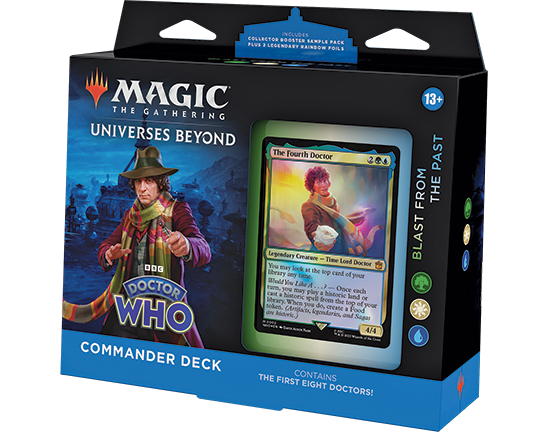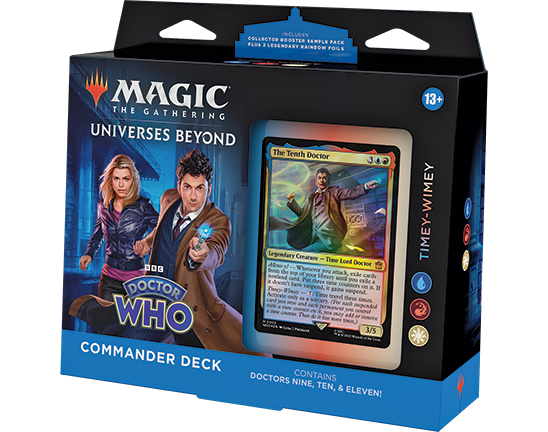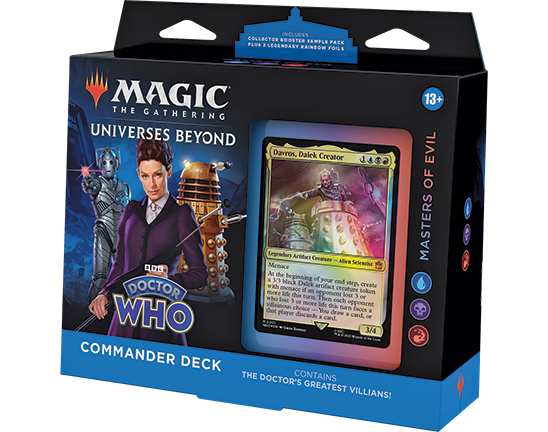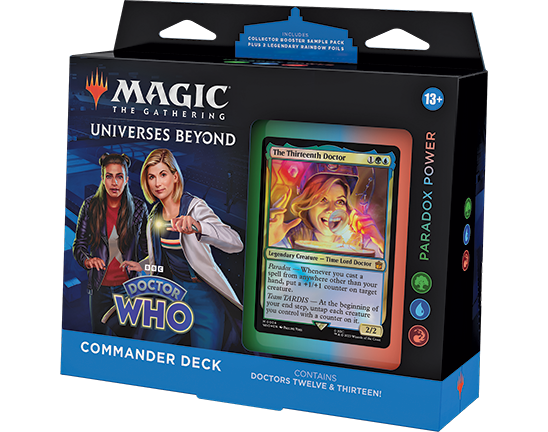Designing Magic: The Gathering® – Doctor Who™
"All of time and space, everything that ever happened or ever will—where do we want to start?"
These are the kinds of questions that kicked off Doctor Who Commander design.
Hey everybody, I'm Gavin Verhey, lead designer on the Doctor Who Commander decks, and huge Doctor Who fan. Such a huge Doctor Who fan that I hid Doctor Who references in every one of my old ReConstructed columns right here on DailyMTG. And as a huge Doctor Who fan, it was quite the road to narrow 60 years of Doctor Who down into four Commander decks.
Of course, a Doctor is nothing without a TARDIS full of allies. And fortunately, I had an amazing design team.
First up, Chris Mooney. Chris has a fun Doctor Who origin story: they actually got into the show over a decade ago because of an episodes watch list I wrote! It's truly like some real Doctor Who episode plot that writing that list back then allowed Chris to get into the show so they could work on the decks now.
As is typical in Commander deck design, each person focused on one deck, though with Universes Beyond there's definitely a lot more of everyone checking in on everything to make sure their top moments are hit. As a huge fan of the Twelfth Doctor, Chris's focus was the Paradox Power deck, and they did a great job bringing it to life.
Next, Carmen Klomparens! (Formerly Carmen Handy—congratulations to her on her recent marriage!) A Doctor Who fan who leapt at the opportunity to join this product, I felt very fortunate to be able to steal some time away from her play design duties for this one. She was crucial not only for making awesome cards, but also for tapping into her play design instincts around balance. Her favorite era of the show—and I'm sure for many of you as well—was the Ninth, Tenth, and Eleventh Doctor era, so she got to be the mastermind behind the Timey-Wimey deck.
Next, a name many of you might recognize from his work on this site and social media: Trick Jarret! One thing we like to do is bring in people who are subject matter experts throughout the company, and while design isn't his main job, I always really appreciate people coming in who aren't as deep into design. They usually have excellent raw, untapped ideas to refine. For example, the Cyberman mechanic in this set (turning creatures face down into 2/2s) came directly from Trick. That's the kind of space I think a lot of designers wouldn't touch because morph carved that space out, but it ended up being a perfect fit for the set! Trick led the Villains deck at the beginning of design, and then departed the team as we started to move out of the vision phase and toward more final design …
And that's where Elizabeth Rice came in! Elizabeth—or Eli—was a brand-new hire to Wizards at the time, and she took over the Villains deck. She loves Doctor Who. Imagine your first day at Wizards and being told that you're going to work on a top-secret Doctor Who product. Not a bad first day at all! It was a really great opportunity to get Eli's raw designs, and also provide feedback as she picked up what it's like to design cards inside Wizards. I'm happy to report many of her designs ended up in the set, which is pretty meaningful as the first thing she ever got to work on at Wizards!
And finally, Jess Dunks. Jess is a rules manager here at Wizards, as well as a huge Whovian. (You might be noticing a consistent theme among the team members here.) He joined the team about halfway through, and I was glad to have him on board, not only to help keep an eye on all the wild cards we were trying to create from a design perspective (of which there are many!), but also as someone who intimately knows Magic and could make some clever designs. He worked on all the decks a little bit and was a great extra person to have around for playtests, especially for focus work on the classic deck. I greatly appreciate the contributions he made to the set, both from rules and design!
And then finally … me! You probably don't need to hear me introduce myself again, so instead I'll just leap ahead and say the deck I led was the classic deck. I knew the most about classic Doctor Who of anyone on the team and took it upon myself to do the research of watching old episodes and getting to know the series up and down.
I want to call out that it really takes a huge TARDIS, far beyond design, to make this set possible. There were many collaborators all throughout Wizards and the BBC we worked with that were all wonderful, but Lauren Bond on Creative was instrumental in working to figure out the art descriptions and themes of the set, as well as Neale LaPlante Johnson who worked with Lauren. A big thanks to them for a truly immense amount of work on this gargantuan project.
Okay, now that I've introduced the team, let's talk design.
I could write an entire novel about Doctor Who design, but today I want to focus on one specific area and tell that story: picking our deck themes and mechanics. I'm going to start with an overview, and then go deck by deck to talk about how we got to that theme.
Ready? Well then … Allons-y!
Slicing the Decks
One of the hardest things to figure out in all of Doctor Who design was how to divide Doctor Who into four decks.
Unlike many other properties or settings, Doctor Who doesn't neatly factionalize. We tried things like slicing it into Doctors, Companions, Daleks, and Master as the four deck themes, but it didn't feel right. There was so much more to Doctor Who than that! Where did all the fun one-of aliens go? Why were the Doctors and Companions separated from one another? How were we going to make the tenth Dalek different from the others? We tried a lot of variations on this—"Okay, what if one deck was all the Doctors and Companions and another was Daleks and Cybermen and other artifact-y aliens …"—but nothing was quite working. Then one day, Chris Mooney and I locked ourselves in a meeting room and resolved not to leave until we had a solution.
After a lot of going back and forth, what we hit upon was dividing it in the same way fans divide themselves: by era of the show. When did you start watching? It was a natural way to split it up! And that's how we ended up with the divisions of classic era; Ninth, Tenth, and Eleventh era; the newest Twelfth and Thirteenth era; and then all the villains in one place. Many of the villains span the run of the whole show, so it made sense to put them together.
However, from a design standpoint I knew that eras, while good, wasn't as strong of connective tissue as something like a faction. So, I really wanted to find a mechanic for each deck, something that each deck could really make its own, so that even if you didn't know the eras of Doctor Who, you could call the deck by its mechanic.
Some of them took longer than others. I'll go in the order that we found our themes.
Classic Deck: Historic

One of the things we did early on the design team was to write down all the existing mechanics that would be fun to bring into Magic: The Gathering® – Doctor Who. There were a lot of great contenders, especially for one-of designs, but historic was a word that carried a lot of resonance in Doctor Who. I knew I wanted one, maybe two, of our mechanics to be returning ones. And when I put the connection together of doing classic Doctor who is historic, it really made a lot of sense.
Flavorfully, many episodes of Doctor Who involve going into the past—some fans even call them historicals! From a meta perspective, it is the oldest and longest age of Doctor Who—literally with the most history. From a mechanical standpoint, it was going to be the deck with the most legendary creatures and trinkets to show off. (And we didn't know it at the time, but also the most sagas!)
I also liked that it was likely to create more of a linear deck: play historic cards on a board full of cards that care about historic triggers, then get rewarded for it. It was likely some of our themes would end up a little more atypical, and so it was a great grounding theme to have.
It's also worth calling out that as our dynamic around Doctors and companions fell into place, with Doctors being two colors and companions being one color, this deck became a place with a ton of extra companions to mix and match with. Both in this deck and the other decks there are several fun companions that aren't just solely about historic.
This theme fell into place pretty quickly, and it certainly makes sense that we would find the thing that already existed first.
That brings us along to our second theme.
Ninth, Tenth, and Eleventh: Time Travel

When we did our initial mechanical exploration, another returning Magic mechanic that stood out was suspend. I mean, it used time counters! It premiered in a Magic time travel set! The theme was so good!
But there were a lot of questions around it, too. There aren't that many great Commander cards with suspend, and it's not a stellar Commander mechanic, because it takes so long—a card with suspend 4 takes four whole turn cycles to get anything from, which in a Commander game allows for so many other players to take actions. We started talking about it, and the idea was resonant, but how was it going to be executable?
Then one afternoon it hit me while thinking about proliferate: What if manipulating counters that felt like time was our theme? This would also help you speed up your suspended cards, which was a huge part of the problem. I pitched an initial concept for the time-travel mechanic, and everybody was interested in giving it a shot.
Now, my initial pitch was actually quite a bit more expansive. It referenced time counters, yes, but also age and lore counters, age being from cumulative upkeep, and lore being from Sagas. That way it opened up how many cards in Magic it worked with and also let you do things that sounded cool like keeping your Sagas around forever!
Well, as it turns out, it was very cool … to talk about. Keeping your Sagas around forever actually was very processing-intensive, especially when you suddenly found yourself managing three Sagas, and suspend, and cumulative upkeep every turn; the player would often find themselves buried in triggers. It was also weird that suspend triggered in your upkeep and Sagas happened in your main phase, so you couldn't just do them all at once. It was really making this deck complicated, especially for the era that many people knew and would want to check out. We needed to scale back.
To the surprise of no one, cumulative upkeep just wasn't adding much. Sorry cumulative upkeep fans, the delightful design space there just isn't huge.
So, we scaled it back to just working on time counters, which is fitting anyway, putting time as the real focus of the deck. This had us start to use more of the vanishing mechanic, as well as make some designs that could just accumulate time counters. We tried it out, and it played much more straightforwardly and fun, and it gave us a great and novel direction for the deck.
I will call out, though, for those who still enjoy those kinds of tricks that Time Spiral reprint
Villains: Villainous Choice

The origin of this one is kind of interesting. Somewhat early in design, someone submitted a punisher card, "punisher" being slang for cards like
Okay, hold that thought.
Another thing we learned from playtesting the villains deck is that people liked being the villain. I've never quite seen anything like this in Magic playtests … ever. When people would play the villains deck, they'd try and antagonize the other players (in fun ways), shout "Exterminate!" as they attacked with Daleks, make dastardly deals, and so on.
And that got me thinking: Okay, what if we leaned into that? And that's where villainous choice came from. It started with all of them asking each opponent, and then slowly evolved into several different iterations, some focused on specific players, some focused on all your opponents. The mechanic tested great, and when we ran some focus groups, it actually ranked as one of our highest rated mechanics ever!
But villainous choice isn't really a thematic card to build around (although I did make The Valeyard for people who want to try!); they're just individual cards you put into decks. Instead, to continue with the lean-in, what if you really did want to attack and antagonize everybody?
That's where the group slug idea came from. Abilities like myriad encourage you to attack everyone. There's also a bit of an artifact theme in there as well since Daleks, Cybermen, and more all happen to be artifact creatures.
This deck was a real blast to play, and I hope you all have fun antagonize your opponents (in friendly ways!) with it.
Twelfth and Thirteenth: Paradox

This is definitely the mechanic and theme that took us the longest to find. The other three fell into place, and we were still searching for how we wanted this to work. We knew we wanted a more spell-focused theme—historic was about permanents on the battlefield, time counters usually ended up with permanents on the battlefield, and artifacts (the villains deck originally had a stronger artifacts theme) were going to do a lot on the table—so something that was about doing tricky things with spells felt like a good fit for Magic: The Gathering® – Doctor Who.
Chris Mooney came up with a bunch of ideas. One was pure noncreatures matter. It worked, if a little uninspiring. We talked about casting spells from your graveyard, kind of like the C19 flashback deck, and there was some decent flavorful connection there with the Thirteenth Doctor searching for her past.
But one day Chris told me they had been thinking about it a bunch and wanted to suggest casting spells not from your hand. Chris has pretty good instincts and had been really on the ball during the whole design process, so I figured let's give it a try. Plus, I really enjoyed how the Commander Legends: Battle for Baldur's Gate red-green, cast-from-exile deck turned out.
One thing I loved right off the bat is how it made you feel not unlike the Doctor: you see something that gives you a reward by doing something you can't normally do in Magic. "How do I cast a spell not from my hand??" And then you get to figure out your own ingenious and unique ways trigger the ability. That kind of creativity and ability for open-ended answers felt very Doctor Who. It also let us use a fun smorgasbord of returning mechanics, from foretell to jump-start, which is one of Chris's favorite things to do in Commander preconstructed decks, really putting their mark all over it in a delightful way.
Into the Time Vortex
There's so much to talk about with these preconstructed decks. Between the off-the-wall themes, the most new cards in a series of preconstructed decks ever (at almost 200, it's bigger than an old-style small set!), and character combinations, there's a ton to play with.
But for today, there's a little insight into how we made these decks and selected the themes. It was really an incredible team effort, and I can't wait for you to play with them!
If you have any questions or thoughts, you can always hit me up on social media. If you enjoyed these insights, I'll also be talking about these decks over on Good Morning Magic—come and check it out!
Have a blast and enjoy your time in the many adventures of Doctor Who!
Gavin Verhey
Email: BeyondBasicsMagic@gmail.com
Instagram: GavinVerhey
TikTok: @GavinVerhey
Tumblr: GavInsight
Twitter: @GavinVerhey
YouTube: Good Morning Magic

